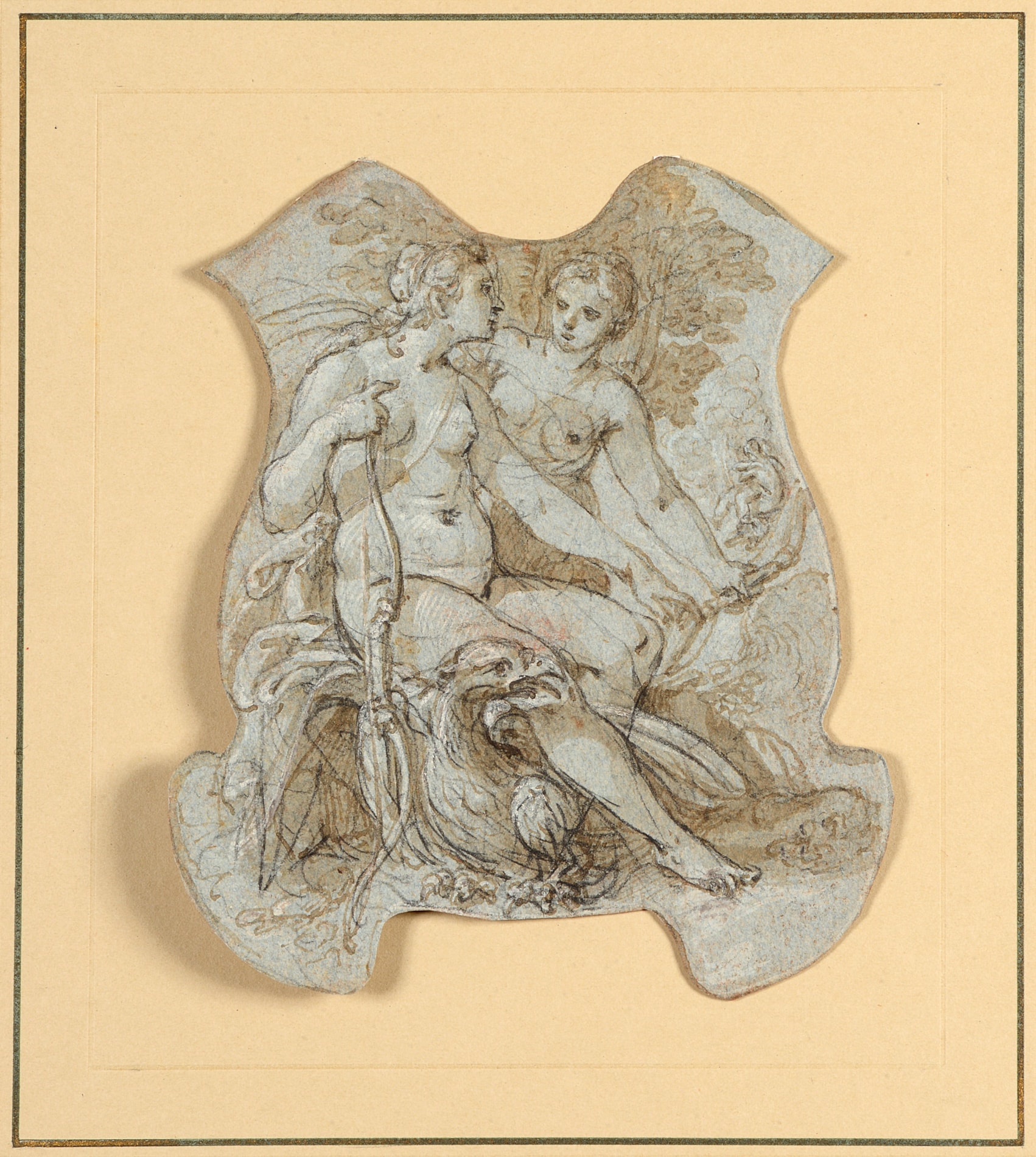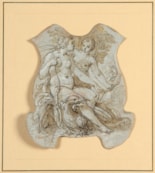Circle of Bartholomeus SPRANGER
(Antwerp c.1546 - Prague 1611)
Jupiter, in the Guise of Diana, Seducing Callisto
Pen and brown ink and brown wash, over an extensive underdrawing in black chalk, with traces of red chalk and touches of white heightening.
The outline shaped, and with framing lines in black chalk.
The verso washed red for transfer.
Inscribed Barth Spranger / Delliniavit on the verso.
Further inscribed (by Geissler) frederic Geissler / graveur a Nuremberg / 1800 on the verso.
125 x 109 mm. (4 7/8 x 4 1/2 in.) at greatest dimensions
The outline shaped, and with framing lines in black chalk.
The verso washed red for transfer.
Inscribed Barth Spranger / Delliniavit on the verso.
Further inscribed (by Geissler) frederic Geissler / graveur a Nuremberg / 1800 on the verso.
125 x 109 mm. (4 7/8 x 4 1/2 in.) at greatest dimensions
This fine drawing has long held an attribution to the Flemish painter and printmaker Bartholomeus Spranger (1546-1611), which is now thought to be untenable. Nevertheless, it is likely to be the work of a contemporaneous or slightly later German or Netherlandish hand. Spranger was active in Rome, Vienna and Prague, and his work became widely known throughout Northern Europe, particularly through reproductive engravings; as such, his style was to prove especially influential among a later generation of Dutch Mannerist painters. With its unusual shape, this small drawing may have been intended as a design for a part of a work of silverware, which is also suggested by the fact that the sheet has been washed red on the verso, to aid in transferring the image.
The inscription on the verso of this drawing identifies a previous owner of the sheet as the 19th century German engraver and draughtsman Johann Martin Friedrich Geissler (1778-1853). Born in Nuremberg, Geissler trained there with the art dealer and print publisher Johann Friedrich Frauenholz. By 1803 he had settled in Paris, working with the publisher Henri Guttenberg and establishing a reputation as a landscape and reproductive engraver. He was one of several printmakers to provide plates for the four-volume Le Musée Français: Recueil complet des tableaux, statues et bas-reliefs qui compose la collection nationale, avec l’explication des sujets et des discours historiques sur la peinture, la sculpture et la gravure, published between 1803 and 1809. Geissler remained in France until 1814, when he returned to Nuremberg. His signature is found on a number of 16th and 17th century prints in museum collections, and it is thought that, alongside his work as a printmaker, he may also have dealt in Old Master prints.
The inscription on the verso of this drawing identifies a previous owner of the sheet as the 19th century German engraver and draughtsman Johann Martin Friedrich Geissler (1778-1853). Born in Nuremberg, Geissler trained there with the art dealer and print publisher Johann Friedrich Frauenholz. By 1803 he had settled in Paris, working with the publisher Henri Guttenberg and establishing a reputation as a landscape and reproductive engraver. He was one of several printmakers to provide plates for the four-volume Le Musée Français: Recueil complet des tableaux, statues et bas-reliefs qui compose la collection nationale, avec l’explication des sujets et des discours historiques sur la peinture, la sculpture et la gravure, published between 1803 and 1809. Geissler remained in France until 1814, when he returned to Nuremberg. His signature is found on a number of 16th and 17th century prints in museum collections, and it is thought that, alongside his work as a printmaker, he may also have dealt in Old Master prints.
Provenance
Johann Martin Friedrich Geissler, Nuremberg and Paris (Lugt 1072), with his inscription on the verso
His posthumous sale, Leipzig, R. Wiegel 10 June 1861 onwards, lot 1170 (B. Spranger. Diana mit einer Nymph, als Barock-Medallion. Feder und Tusche.)
Iohan Quirijn van Regteren Altena, Amsterdam (his posthumous sale stamp [Lugt 4617] stamped on the verso), until 1980
By descent to his wife, Augusta Louisa Wilhelmina van Regteren Altena, née van Royen, Amsterdam, until 2006
Thence by family descent until 2014.
His posthumous sale, Leipzig, R. Wiegel 10 June 1861 onwards, lot 1170 (B. Spranger. Diana mit einer Nymph, als Barock-Medallion. Feder und Tusche.)
Iohan Quirijn van Regteren Altena, Amsterdam (his posthumous sale stamp [Lugt 4617] stamped on the verso), until 1980
By descent to his wife, Augusta Louisa Wilhelmina van Regteren Altena, née van Royen, Amsterdam, until 2006
Thence by family descent until 2014.




